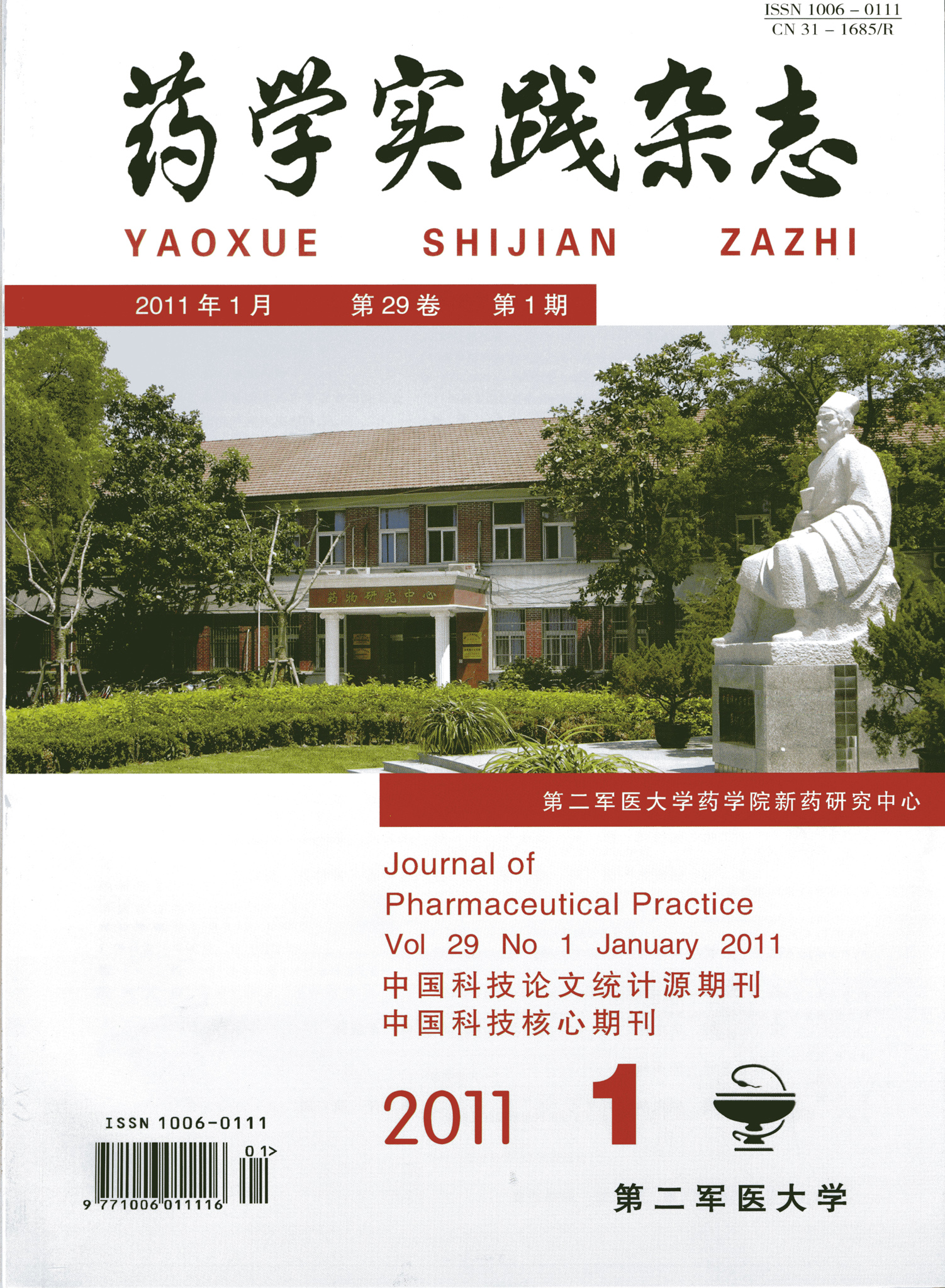|
[1]
|
Brus C, Petersen H, Aigner A, et al. Efficiency of polyethylenimines and polyethyleniminegraft-poly (ethylene glycol) block copolymers to protect oligonucleotides against enzymatic degradation[J]. Eur.J Pharm Biopharm, 2004, (57): 427. |
|
[2]
|
Fischer D, Osburg B, Petersen H, et al. Effect of poly(ethyleneimine) molecular weight and pegylation on organ distribution and pharmacokinetics of polyplexes with oligodeoxynucleotides in mice[J]. Drug Metab Dispos,2004, (32): 983. |
|
[3]
|
Mao S, Neu M, Germershaus O, et al. Influence of polyethylene glycol chain length on the physicochemical and biological properties of poly(ethylene imine)-graft-poly(ethylene glycol) block copolymer/SiRNA polyplexes[J]. Bioconjug Chem, 2006 ,(17) : 1209. |
|
[4]
|
Kunath K, von Harpe A, Petersen H, et al. The structure of PEG-modified poly(ethylene imines) influences biodistribution and pharmacokinetics of their complexes with NF-kappaB decoy in mice[J].Pharm Res,2002, (19) : 810. |
|
[5]
|
Zhang Y, Chen J, Zhang Y, et al. A novel PEGylation of chitosan nanoparticles for gene delivery[J].Biotechnol Appl Biochem, 2007 ,(46) :197. |
|
[6]
|
Zhang H, Mardyani S, Chan WC, et al.Design of biocompatible chitosan microgels for targeted pH-mediated intracellular release of cancer therapeutics[J]. Biomacromolecules,2006, (7) :1568. |
|
[7]
|
Kim TH, Nah JW, Cho MH, et al. Receptor-mediated gene delivery into antigen presenting cells using mannosylated chitosan/DNA nanoparticles[J]. J Nanosci Nanotechnol,2006, (6) :2796. |
|
[8]
|
Park IK, Kim TH, Park YH, et al. Galactosylated chitosan-graft-poly(ethylene glycol) as hepatocyte-targeting DNA carrier[J]. J Control Release,2001,(76): 349. |
|
[9]
|
Mansouri S, Cuie Y, Winnik , et al. Characterization of folate-chitosan-DNA nanoparticles for gene therapy[J].Biomaterials,2006, (27) :2060.. |
|
[10]
|
Jiang H, Kwon J, Kim E, et al. Galactosylated poly(ethylene glycol)-chitosan-graft-polyethylenimine as a gene carrier for hepatocyte-targeting[J]. J Control Release, 2008, (131) :150. |
|
[11]
|
Schaffer DV, Lauffenburger DA, Optimization of cell surface binding enhances efficiency and specificity of molecular conjugate gene delivery[J]. J Biol Chem,1998, (273) :28004. |
|
[12]
|
Benns JM, Choi JS, Mahato RI, et al. pH sensitive cationic polymer gene delivery vehicle: N-Acpoly( L-histidine)-graft-poly(L-lysine) comb shaped polymer[J]. Bioconjug Chem,2000, (11): 637. |
|
[13]
|
Li W, Nicol F, Szoka Jr FC, GALA: a designed synthetic pH-responsive amphipathic peptide with applications in drug and gene delivery[J]. Adv Drug Deliv Rev, 2004, (56) :967. |
|
[14]
|
Wagner E, Effects of membrane-active agents in gene delivery[J].J Control Release, 1998, (53) :155. |
|
[15]
|
Jones RA, Cheung CY, Black FE, et al. Poly(2-alkylacrylic acid) polymers deliver molecules to the cytosol by pHsensitive disruption of endosomal vesicles[J]. Biochem J, 2003, (372) :65. |
|
[16]
|
Kim TH, Kim SI, Akaike T, et al. Synergistic effect of poly(ethylenimine) on the transfection efficiency of galactosylated chitosan/DNA complexes[J].J Control Release, 2005, (105) :354. |
|
[17]
|
Thanou M, Florea BI, Geldof M, et al. Quaternized chitosan oligomers as novel gene delivery vectors in epithelial cell lines[J]. Biomaterials, 2002, (23): 153. |
|
[18]
|
Mao S, Shuai X, Unger F, et al. Synthesis, characterization and cytotoxicity of poly (ethylene glycol)-graft-trimethyl chitosan block copolymers[J]. Biomaterials, 2005,(26) : 6343. |
|
[19]
|
Satoh T, Kano H, Nakatani M, et al. 6-Amino-6-deoxy chitosan. Sequential chemical modifications at the C-6 positions of N-phthaloylchitosan and evaluation as a gene carrier[J].Carbohydr Res,. 2006, (341) : 2406. |
|
[20]
|
Park IK, Ihm JE, Park YH, et al. Galactosylated chitosan(GC)-graftpoly(vinyl pyrrolidone) (PVP) as hepatocytetargeting DNA carrier: preparation and physicochemical characterization of GCgraft-PVP/DNA complex (1) [J]. J Control Release,2003, (86) : 349. |
|
[21]
|
Wong K, Sun G, Zhang X, et al. PEI-g-chitosan, a novel gene delivery system with transfection efficiency comparable to polyethylenimine in vitro and after liver administration in vivo[J].Bioconjug Chem,2006, (17) : 152. |
|
[22]
|
Kurisawa M, Yokoyama M, Okano T, Transfection efficiency increases by incorporating hydrophobicmonomer units into polymeric gene carriers[J].J Control Release,2000, (68) : 1. |
|
[23]
|
Kim YH, Gihm SH, Park CR, et al. Structural characteristics of size-controlled self aggregates of deoxycholic acidmodified chitosan and their application as a DNA delivery carrier[J].Bioconjugate Chem,2001 ,(12) : 932. |
|
[24]
|
Liu WG, Zhang X, Sun SJ, et al. N-alkylated chitosan as a potential nonviral vector for gene transfection[J]. Bioconjugate Chem,2003, (14) : 782. |
|
[25]
|
Hu F, Zhao M, Yuan H, et al. A novel chitosan oligosaccharidestearic acid micelles for gene delivery: properties and in vitro transfection studies[J]. Int J Pharm,2006,(315) : 158. |
|
[26]
|
Mao Z, Ma L, Yan J, et al. The gene transfection efficiency of thermoresponsive N, N, N-trimethyl chitosan chloride-g-poly(N-isopropylacrylamide) copolymer[J]. Biomaterials,2007, (28) : 4488. |








 DownLoad:
DownLoad: